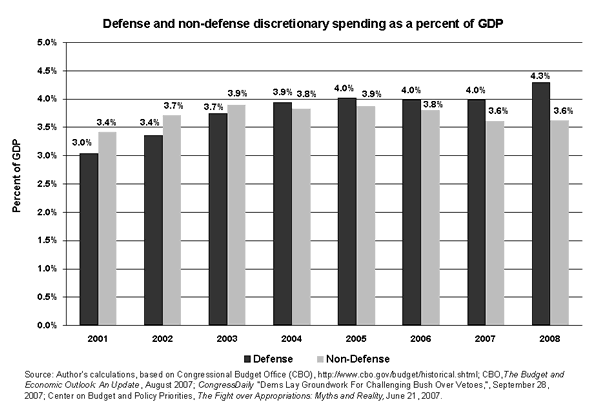See Snapshots archive.
Snapshot for October 10, 2007.
War spending placed above domestic priorities
Claiming the mantle of fiscal discipline, President Bush has threatened to veto spending bills that exceed his budget request, even though Congress’s non-defense appropriations bills approximately keep pace with economic growth. Meanwhile, the administration has asked for significant increases in both war appropriations and regular defense appropriations for 2008. Defense spending, which rose from 3.0% of GDP when Bush came into office in 2001 to 4.0% in 2005-07, will resume its upward climb to 4.3-5.0% of GDP in 2008 if Congress agrees to the president’s request.1
The chart below illustrates what happens if the president gets his way on the war and Congress gets its way on domestic spending. It shows that the entire increase in discretionary spending as a share of GDP since 2002 (the first year President Bush had any input on the budget) will be due to a growth in defense spending rather than domestic initiatives.2 The proposed $70 billion increase in defense appropriations for 2008 would be more than enough to fund the $35 billion expansion of the State Children’s Health Insurance Program that the president just vetoed. In addition, it would make up the $21 billion difference between the president and Congress on domestic appropriations bills that the president has threatened to veto. Polls show that voters are concerned that defense spending—especially on the Iraq war—is placed above government spending on health care, education, and other domestic priorities. The voters are right.

Note: Where they differ, Senate and House appropriations bills are averaged. Assumes that the ratio of outlays to appropriations is the same in fiscal 2007 and fiscal 2008. In the case of defense spending, the difference between outlays and appropriations reflects the fact that war funds are not necessarily spent within a fiscal year, and appropriations bills are not cleanly split along functional lines. In the case of non-defense spending, the discrepancy is due to spending from the Highway Trust Fund and the Airport and Airway Trust Fund, which is not included in appropriations bills.
Endnotes
1. The 4.3% estimate assumes that the ratio of defense outlays and defense appropriations, as measured by the Congressional Budget Office, is the same in fiscal 2008 as fiscal 2007. The 5.0% estimate assumes that the full $524 billion requested for defense, military construction, and veterans’ affairs, as well as the $193 billion in war funding requested so far are spent in fiscal 2008.
2. The chart actually understates the full cost of the “war on terror,” because Homeland Security, State Department, and Foreign Operations funding is included in non-defense spending. Significant long-term war costs, for veterans’ health care, for example, are also not included.
